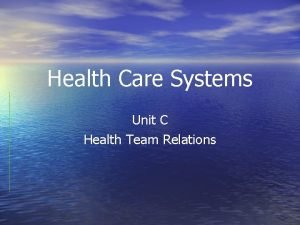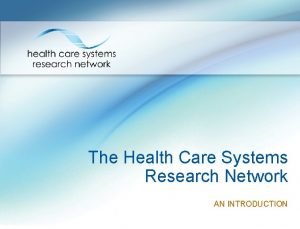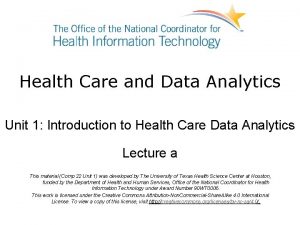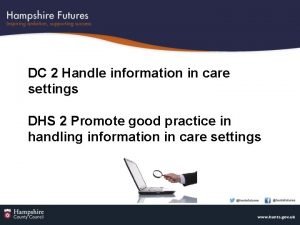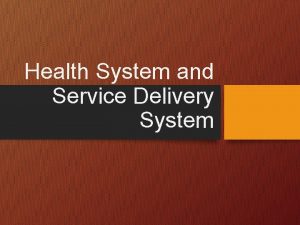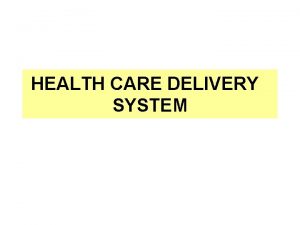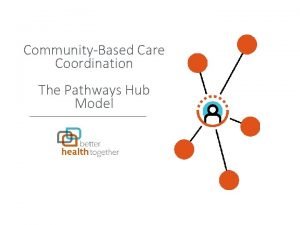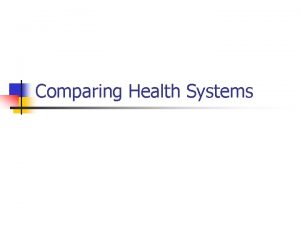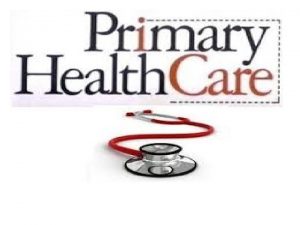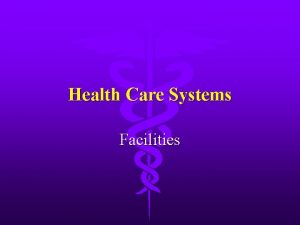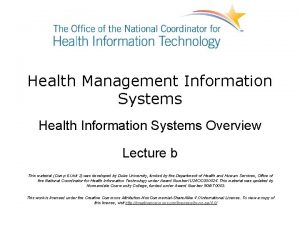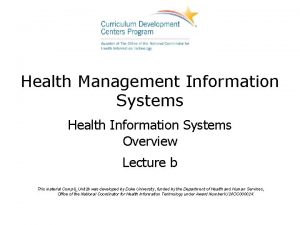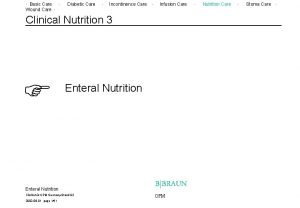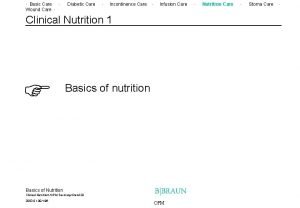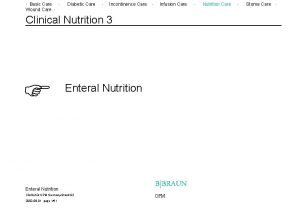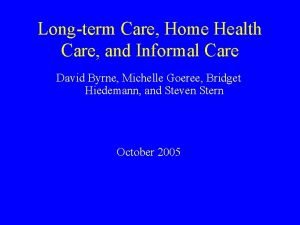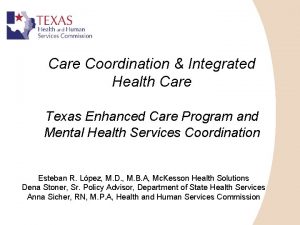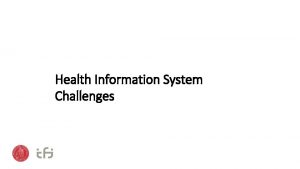Health Care Information Systems Information System Information system




















- Slides: 20

Health Care Information Systems

Information System • Information system: Use of computer hardware and software to process data into information to solve problems • Healthcare information system (and hospital information system)—a group of systems used to support and enhance healthcare

HIS • HIS comprises of two major types of information system: – Clinical Information system – Administrative information system

Types of Information Systems • Clinical information systems (CISs) – Directly support care – Plan, implement, evaluate patient care – Physician orders – Results retrieval – Documentation • Administrative systems – Indirectly support patient care by managing financial and demographic info

Clinical Information Systems (CISs) • • • Nursing Multidisciplinary Monitoring Laboratory Pharmacy Radiology

Administrative Systems • • • Client management (registration) Financial Payroll Human resources Quality assurance Contract management

Nursing Information System (NIS) • Supports the use and documentation of nursing process, activities and provides tools for managing the delivery of nursing care • Support the nurses functions – Access to PMH, allergies, test results, progress notes • Support nursing practice – Access to online databases such as MEDLINE

Nursing Information System Advantages • • • Improved access to information Better documentation Improved quality of care Improved productivity and communications Tracking capability Enhanced regulatory compliance

NIS Status • Despite advantages, information systems that are used by all clinicians are seen more commonly.

Two approaches for nursing documentation 1. Nursing process: automated documentation based on traditional documents with nursing diagnosis as organizing framework, may use standardized nursing languages – Allow documentation using structured format • Admission assessment • Problem list • Care plan

Nursing process approach • Documentation of nursing admission assessment and discharge • Documentation of discrete data such as VS • Standard care plans • Nursing notes in a progress note format • Documentation of med administration

Standardized Nursing Languages • Provide a common language across all nursing disciplines to describe nursing problems, Rx, and outcomes. – North American Nursing Diagnosis Ass. (NANDA) – Nursing Interventions Classifications (NIC) – Nursing Outcomes Classification (NOC) • Measure nursing’s contributions • Contribute to the body of nursing knowledge

Two approaches for nursing documentation • 2. Critical pathway—often used for multidisciplinary documentation, may incorporate physician orders • Used by everyone – Nurses, dietitians, social workers, physicians …

Clinician Information Systems CIS • Can be used by any clinician • User may be able to edit the data while others’ access may be limited to viewing the data • Support provider order entry, results retrieval, documentation • Wireless networks more convenience

Monitoring • These devices monitor temperature, pulse, respirations, blood pressures, oxygen saturation, or other measures automatically feeding the input into a clinical information system. – No need to enter BP manually • Alarms notify caregivers of readings that are outside the range of “normal. ”

Order Entry Systems • Orders entered into the computer are transmitted to the appropriate areas such as the pharmacy, laboratory, radiology, and social services. – Eliminate issues related to illegible hand writing – Faster – Enhance staff productivity – Save money

CPOE • Computerized provider order entry • Initiative by the Institute of Medicine and Leapfrog Group to improve the quality of care and reduce medication errors – Eliminates transcription error – Expedites treatment – Encourages more accurate, complete orders – Order entry system alerts all departments to carry out orders – List order status: Pending, complete, cancelled

Laboratory Information Systems • Issues that LIS address – Identification of abnormal results – Duplicate testing – Errors

Laboratory Information Systems • Can do the following: – Alert providers when new or stat tests results are back or values are critical – Send results to clinical system for view – Accept input from bedside devices – Generate labels for specimen collection – Use rules to order additional tests when indicated – Send critical values to PCP – Culture and sensitivity testing suggest treatment to PCP

Questions?
 Levels of care primary secondary tertiary
Levels of care primary secondary tertiary Health and social care unit 2
Health and social care unit 2 Health team relations
Health team relations Hcsrn
Hcsrn Chapter 2 health care systems
Chapter 2 health care systems Introduction to healthcare data analytics
Introduction to healthcare data analytics Health and social component 3
Health and social component 3 Data protection act in health and social care settings
Data protection act in health and social care settings 10 difference between health education and health promotion
10 difference between health education and health promotion The objective for health service delivery is to
The objective for health service delivery is to Secondary care definition
Secondary care definition Introduction of health care delivery system
Introduction of health care delivery system Health care system definition
Health care system definition Standard 3 duty of care
Standard 3 duty of care Magnetul este un corp care atrage
Magnetul este un corp care atrage Palliative care vs hospice care
Palliative care vs hospice care Inmultirea animalelor
Inmultirea animalelor Care sunt simturile prin care sunt evocate
Care sunt simturile prin care sunt evocate Standard 9 care certificate answers
Standard 9 care certificate answers Hip fracture clinical care standard
Hip fracture clinical care standard Central hub bht
Central hub bht


